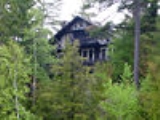
Prospect Point Camp
Encyclopedia
Prospect Point Camp is an Adirondack
Great Camp notable for its unusual chalet
s inspired by European hunting lodges. William L. Coulter
's design is a significant example of the Adirondack Rustic style. It is located on a bluff overlooking the northern reaches of Upper Saranac Lake
, near Eagle Island Camp and Moss Ledge
, two other Coulter designs. Its grand scale is typical of the opulent camps of the area in the great camp era. The camp was built for New York
copper magnate and financier Adolph Lewisohn
.
In a departure from the tendency of camps to be sheltered in the woods, Prospect Point Camp towers over its shoreline, approached by several broad flights of steps from the water. The main lodge is a three story chalet with a half-timbered effect, with birch bark filling the role usually played by brick or stucco. Birch bark is also used as a ceiling treatment between the beams. Interior walls were finished with local spruce, but also with southern pine, stained green or tan. The boathouse was the largest on the lake. The camp had a gasoline powered generator, and telephones throughout.
In the 1940s, the camp was sold, and had a brief career as a lodge, Sekon in the Pines. It was sold again in 1951, and used as a summer camp for young Jewish girls. In 1969, it was purchased by Young Life
, a Christian non-denominational ministry based in Colorado Springs, Colorado
, who use it for one-week long educational camping sessions.
The camp was included in a multiple property submission of 10 camps for listing on the National Register of Historic Places
, and was itself listed in 1986.

Adirondack
__notoc__Adirondack may refer to:*Adirondack Mountains, *Adirondack County, New York, a proposed county in New York...
Great Camp notable for its unusual chalet
Chalet
A chalet , also called Swiss chalet, is a type of building or house, native to the Alpine region, made of wood, with a heavy, gently sloping roof with wide, well-supported eaves set at right angles to the front of the house.-Definition and origin:...
s inspired by European hunting lodges. William L. Coulter
William L. Coulter
William Lincoln Coulter was an architect who came to Saranac Lake, New York in the spring of 1896 in an effort to cure his tuberculosis, and stayed to design some of the finest Adirondack Great Camps and Cure Cottages in the area...
's design is a significant example of the Adirondack Rustic style. It is located on a bluff overlooking the northern reaches of Upper Saranac Lake
Upper Saranac Lake
Upper Saranac Lake is one of three connected lakes, part of the Saranac River, in the towns of Santa Clara and Harrietstown, near the village of Saranac Lake in the Adirondacks in northern New York. Upper Saranac Lake is the sixth largest lake in the Adirondacks. With Middle Saranac Lake and...
, near Eagle Island Camp and Moss Ledge
Moss Ledge
Moss Ledge is an Adirondack Great Camp designed by William L. Coulter in 1898 for Isabel Ballantine of New York City. Ballantine was the daughter of Newark beer baron, John Holmes Ballantine....
, two other Coulter designs. Its grand scale is typical of the opulent camps of the area in the great camp era. The camp was built for New York
New York City
New York is the most populous city in the United States and the center of the New York Metropolitan Area, one of the most populous metropolitan areas in the world. New York exerts a significant impact upon global commerce, finance, media, art, fashion, research, technology, education, and...
copper magnate and financier Adolph Lewisohn
Adolph Lewisohn
Adolph Lewisohn was a German-Jewish immigrant born in Hamburg who became a New York City investment banker, mining magnate, and philanthropist. He is the namesake of the former School of Mines building on the Morningside Heights campus of Columbia University, as well as the former Lewisohn Stadium...
.
In a departure from the tendency of camps to be sheltered in the woods, Prospect Point Camp towers over its shoreline, approached by several broad flights of steps from the water. The main lodge is a three story chalet with a half-timbered effect, with birch bark filling the role usually played by brick or stucco. Birch bark is also used as a ceiling treatment between the beams. Interior walls were finished with local spruce, but also with southern pine, stained green or tan. The boathouse was the largest on the lake. The camp had a gasoline powered generator, and telephones throughout.
In the 1940s, the camp was sold, and had a brief career as a lodge, Sekon in the Pines. It was sold again in 1951, and used as a summer camp for young Jewish girls. In 1969, it was purchased by Young Life
Young Life
YoungLife is a worldwide, non-profit, Evangelical Christian organization. YoungLife consists of many branches of ministry , but most commonly the name "YoungLife" refers to the outreach arm of the organization directed toward high school students...
, a Christian non-denominational ministry based in Colorado Springs, Colorado
Colorado Springs, Colorado
Colorado Springs is a Home Rule Municipality that is the county seat and most populous city of El Paso County, Colorado, United States. Colorado Springs is located in South-Central Colorado, in the southern portion of the state. It is situated on Fountain Creek and is located south of the Colorado...
, who use it for one-week long educational camping sessions.
The camp was included in a multiple property submission of 10 camps for listing on the National Register of Historic Places
National Register of Historic Places
The National Register of Historic Places is the United States government's official list of districts, sites, buildings, structures, and objects deemed worthy of preservation...
, and was itself listed in 1986.
Sources

- Gilborn, Craig. Adirondack Camps: Homes Away from Home, 1850-1950. Blue Mountain Lake, NY: Adirondack Museum; Syracuse: Syracuse University Press, 2000.

